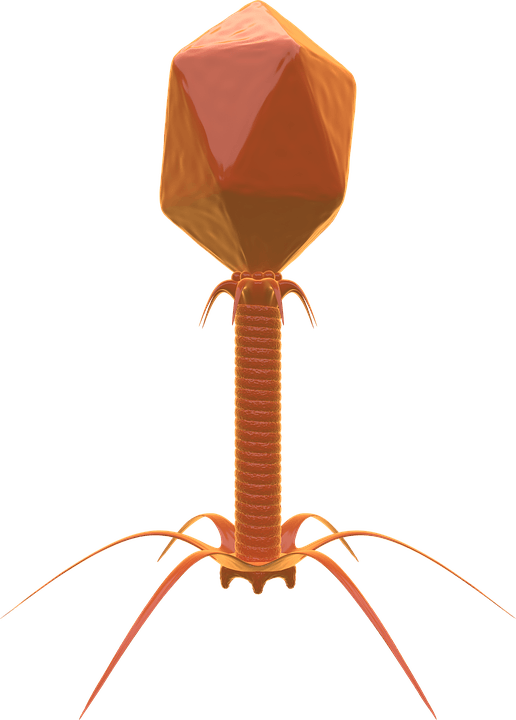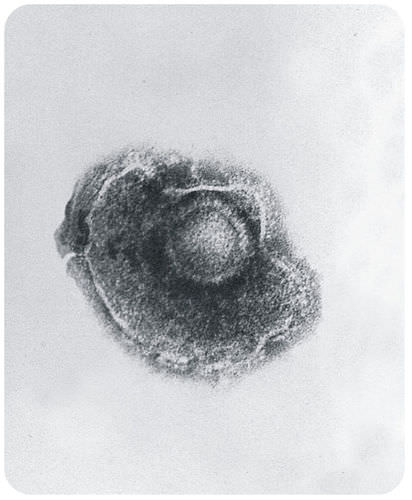病毒结构 - 高级
章节大纲
-
Does it really look like this?
::真的这样吗?Some do. It's not a simple structure, so it must be complex. But really it is just and . The nucleic acid is enclosed in what looks like a "head" region, so everything else must be protein.
::有些是。 它不是一个简单的结构, 所以它一定很复杂。 但是它确实是公正的。 核酸被封闭在像“ 头” 的区域里, 所以其他的必须是蛋白质。Virus Structure
::病毒结构A complete virus particle is called a virion . A virion is made up of nucleic acid ( or RNA) surrounded by a protective protein shell called a capsid . The capsid is made from the proteins that are encoded by viral genes . The shape of the capsid serves as one basis for the of viruses. The capsid of the mimivirus, shown in Figure , is icosahedral. Virally coded proteins will self-assemble to form a capsid. Viruses can have a envelope that is made from the host's when they move out of the . The viral envelope helps the virus enter host cells. Many viruses (e.g. influenza and many viruses) have viral envelopes covering their protein capsids. If a virus has an outer viral envelope, it usually indicates that the virus exits the host cell by budding off (exocytosis).
::完整的病毒粒子称为病毒。 病毒由核酸( 或RNA) 组成, 由保护性蛋白壳( 或RNA) 环绕, 叫做 capsid 。 其卡布西德 是由病毒基因编码的蛋白质制成的。 卡布西德 的形状是病毒的一个基础。 图中显示的咪米病毒的盖子是象萨氏体。 动态编码的蛋白质将自动组成一个卡布西德。 病毒可以有一个包件, 由宿主携带, 当他们搬出时由宿主制成。 病毒的病毒信封帮助病毒进入宿主细胞。 许多病毒( 如流感和许多病毒) 的病毒信封覆盖着他们的蛋白封。 如果病毒有外病毒信封, 它通常表示病毒通过发芽( 异性病) 离开宿主细胞。Diagram of a Cytomegalovirus. The capsid encloses the genetic material of the virus. The envelope which surrounds the capsid is typically made from portions of the host's cell membranes (phospholipids and proteins). Not all viruses have a viral envelope. In this figure, glycoproteins are identified on the coat of the virus as "Glycoprotein" Helical Viruses
::肝肝病毒Helical capsids are made up of a single type of protein subunit stacked around a central axis to form a helical structure. The helix may have a hollow center, which makes it look like a hollow tube. This arrangement results in rod-shaped or filamentous virions. These virions can be anything from short and very rigid, to long and very flexible. The well-studied tobacco mosaic virus (TMV), shown in Figure , is an example of a helical virus.
::螺旋藻是由一种单型的蛋白亚单位组成,它堆在中央轴周围,形成一个螺旋结构。螺旋体可能有一个空心中心,使它看起来像一个空心管。这种安排产生棒状或丝状的病毒。这些病毒可以是短的、非常僵硬的、长的和非常灵活的。图中显示的经过深思熟虑的烟草混合病毒(TMV)就是一种螺旋病毒的一个例子。Tobacco mosaic virus, a helical virus. Although their diameters may be very small, some helical viruses can be quite long, as shown here. 1. Nucleic acid 2. Viral protein units 3. Capsid. TMV causes tobacco mosaic disease in tobacco, cucumber, pepper, and tomato plants. Icosahedral Viruses
::Icosahedr病毒An icosahedral virus contains a capsid of 20 identical (equilateral) triangles. The icosahedral capsid symmetry gives these viruses a spherical appearance at low magnification. But the protein subunits are actually arranged in a regular geometrical pattern, similar to a soccer ball; they are not truly "spherical," as shown in Figure . An icosahedral shape is the most efficient way of creating a hardy structure from multiple copies of a single protein. This shape is used because it can be built from a single basic unit of protein which is used over and over again; this saves space in the viral genome . The mimivirus, shown in Viruses: Characteristics (Advanced), is an example of an icosahedral virus.
::象形突变病毒包含20个相同( 等质) 三角形的顶部。 象形突变对称法使这些病毒在低放大度时呈现球状。 但蛋白质亚单位实际上以常规几何模式排列, 类似于足球球; 它们并非如图所示真正“ 球状 ” 。 象形形是用多个蛋白质复制件创建硬体结构的最有效方式。 之所以使用这个形状,是因为它可以用一个基本蛋白单位来构建, 并且反复使用; 这在病毒基因中节省了空间。 病毒: 特征( 高级) 显示的微米病毒是象形病毒的一个例子。Adenovirus, an icosahedral virus. An icosahedron is a three-dimensional shape made up of 20 equilateral triangles. Viral structures are built of repeating, identical protein subunits, making the icosahedron the easiest shape to assemble using these subunits. Complex Viruses
::复杂病毒Complex viruses possess capsids which are neither purely helical nor purely icosahedral. These capsids may have extra structures such as protein tails or a complex outer wall. Viral protein subunits will self-assemble into a capsid, but the complex viral DNA also codes for proteins which help in building the viral capsid. Many phage viruses are complex-shaped; they have an icosahedral head bound to a helical tail, as shown in Figure . The tail may have a base plate with protein tail fibers. Some complex viruses do not have tail fibers.
::复杂病毒具有既非纯粹的螺旋状又非纯粹的皮层状病毒。这些皮层状病毒可能具有额外的结构,如蛋白尾巴或复杂的外墙。活性蛋白亚单位将自我组装成一个顶层,但复杂的病毒DNA也含有有助于建立病毒顶部的蛋白质编码。许多象形病毒是复杂的;它们有一个皮层头,被皮层尾巴捆绑在一起,如图所示。尾部可能有一个带有蛋白尾纤维的底板。有些复杂的病毒没有尾部纤维。These “moon lander” shaped complex viruses infect Escherichia coli bacteria. Enveloped Viruses
::病毒 病毒 病毒 病毒 病毒 病毒 病毒 病毒 病毒 病毒 病毒 病毒 病毒 病毒 病毒 病毒 病毒 病毒 病毒 病毒 病毒 病毒 病毒 病毒 病毒 病毒 病毒 病毒 病毒 病毒 病毒 病毒 病毒 病毒 病毒 病毒 病毒 病毒 病毒 病毒 病毒 病毒 病毒 病毒 病毒 病毒 病毒 病毒 病毒 病毒 病毒 病毒 病毒 病毒 病毒 病毒 病毒 病毒 病毒 病毒 病毒 病毒 病毒 病毒 病毒 病毒 病毒 病毒 病毒 病毒 病毒 病毒 病毒 病毒 病毒 病毒 病毒 病毒 病毒 病毒 病毒 病毒 病毒 病毒 病毒 病毒 病毒 病毒 病毒 病毒 病毒 病毒 病毒 病毒 病毒 病毒 病毒 病毒Some viruses are able to surround (envelope) themselves in a portion of their host's cell membrane; these are known as enveloped viruses. The virus can use either the outer membrane of the host cell or an internal membrane, such as the nuclear membrane or the membrane of the . In this way, the virus gains an outer lipid bilayer known as a viral envelope. This membrane is studded with proteins coded by both the viral genome and the host genome; however, the lipid membrane itself and any present come entirely from the host cell. The influenza virus, , and the varicella zoster virus, shown in Figure , are enveloped viruses.
::有些病毒能够将(病毒)本身包围在宿主细胞膜的一部分内,这些病毒被称为包装病毒,病毒可以使用宿主细胞的外膜,也可以使用内膜,如核膜膜或内膜。这样,病毒就产生了一个外脂双层,称为病毒包。这种膜由病毒基因组和宿主基因组编码的蛋白质组成;然而,脂质膜本身和任何出现的情况都可以完全来自宿主细胞。图中显示的流感病毒和虫动物病毒都是包装病毒。Varicella zoster, an enveloped virus which causes chicken pox and shingles. The viral envelope can give a virus some advantages over capsid-only viruses. For example, they have better protection from the host's immune system , , and certain chemicals. The proteins in the envelope can include glycoproteins which act as receptor molecules. These receptor molecules allow host cells to recognize and bind the virions, which may result in easier uptake of the virion into the host cell. Most enveloped viruses depend on their envelopes to infect cells. However, because the envelope contains lipids, it makes the virus more susceptible to inactivation by environmental agents, such as detergents that disrupt lipids.
::病毒信封可以给病毒一些优势, 而不是只覆盖病毒。 例如, 它们可以更好地保护病毒不受宿主的免疫系统、 和某些化学物质的影响。 信封中的蛋白质可以包括作为受体分子的胶质蛋白。 这些受体分子可以让宿主细胞识别和捆绑病毒, 这可能使得病毒更容易被吸收到宿主的细胞中。 大多数被围病毒依靠信封感染细胞。 但是, 信封中含有脂质, 它使得病毒更容易被环境物剂, 比如干扰脂肪的洗涤剂, 使病毒更容易被消散 。Summary
::摘要-
Viruses are composed of genetic material surrounded by a protective protein shell called a capsid.
::病毒由遗传物质组成,其周围环绕着一个叫做卡比塞的保护性蛋白壳。 -
Viral structures can include helical, icosahedral, complex, and enveloped.
::活性结构可包括直升机、直升机、直升机、复合体和包盖。
Review
::回顾-
Draw, label, and compare the structures of a prokaryote and a virus.
::绘制、标签和比较 prokaryote 和病毒的结构。 -
Describe viral structures.
::描述病毒结构。
-
Viruses are composed of genetic material surrounded by a protective protein shell called a capsid.





